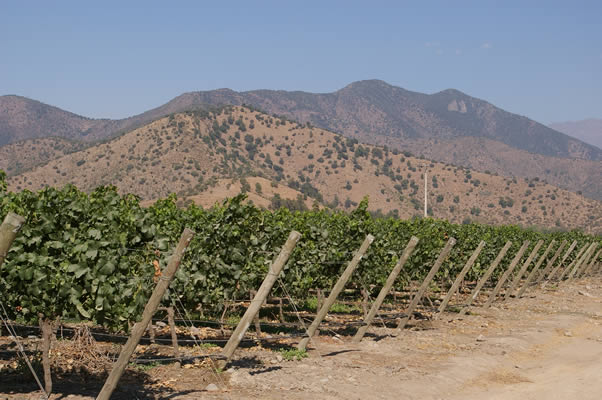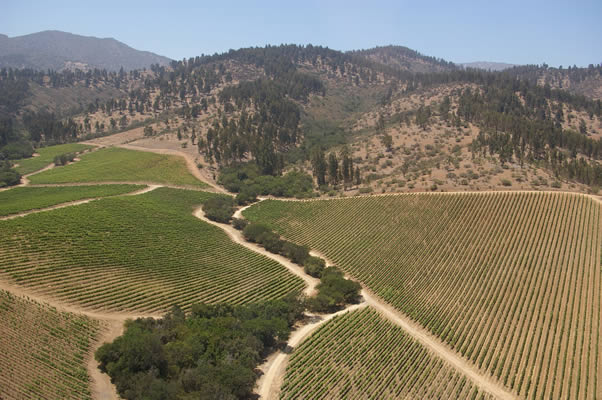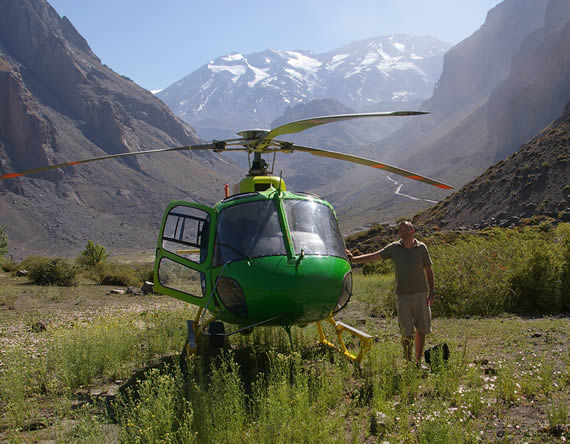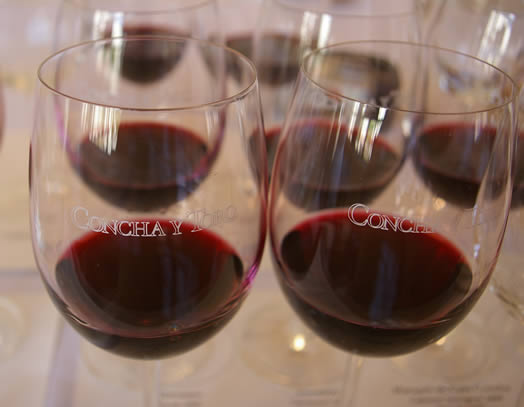|
Visiting
Chile's wine regions
Part 1:
introduction

I’ll
admit it. Before I visited Chile for the first time in January 2008,
I was a Chilean wine sceptic. While I admired Chile’s success in
the crowded UK marketplace, and was impressed by the way Chile was
making so many tasty, affordable wines, I’d never really had any
Chilean wines that I’d considered to be really ‘serious’. My
problem with the high-end Chilean red wines I had experienced was
that they all tasted rather similar, and I could always pick them
out as being Chilean in blind tastings. The taste signature of
almost all Chilean reds seemed to be sweet, pure blackcurrant fruit
with some greenness, and it was all a bit boring. And if I’m going
to be a little uncharitable, I was disillusioned by the expensive
icon wines, which just tasted like more concentrated, sweeter
versions of their less expensive peers.
But
I’m always willing to be proved wrong, and I try to keep an open
mind. This is why I was delighted to be invited to take part in the
fifth Wines of Chile annual awards judging, held in Santiago in
January 2008. Here was a chance to taste widely and broadly across
all levels of Chilean wine, and then to visit some of the top
producers to see what they were up to.

It
would be very tidy if I could say now that this 10 day trip blew
away my misconceptions about Chilean wine, and that I discovered
dozens of really serious, world class wines, but I didn’t.
However, I did find lots of really good wines, and came away
impressed at the trajectory that Chilean wine is taking. It’s a
work in progress, but Chile is making progress pretty fast. New
vineyard areas are being pioneered; new varieties are being tried
out. Yes, there are still quite a lot of rather boring, taste-alike
red wines, but there’s also a new wave of impressive mid-priced
wines filling in the gulf between the cheap and icon wines. And
Chilean whites are making fast progress. If this work continues,
then the future for Chilean wine looks very bright indeed.
Over
the next few weeks I’ll be writing up my experiences in Chile,
trying to capture the flavour of what is going on here. First,
though, a little bit of background on the Chilean wine industry.

Me in the Andes, with my preferred form of transport
Chile
is a long, thin country, hemmed in on one side by the Andes, and on
the other the Pacific ocean. Unlike neighbouring Argentina, which
uses altitude as a way to moderate otherwise high summer
temperatures, Chile’s key climatic influence is the sea, which is
freezing cold (I tried swimming in it – a painful experience),
cooled by the Humboldt Current. Between the vineyard areas and the
sea lies the coastal mountain range, and where there are breaks in
this coastal range, formed by river valleys, cool air is sucked in.
These air movements moderate the otherwise warm temperatures, and
factors such as proximity of the coast and the location of valleys
determines the suitability of vineyard sites for particular grape
varieties. In recent years the search has been on for new cooler
climate wine regions with the potential to make more expressive
wines from a broad repertoire of grape varieties. These new wave
Chilean wines are now hitting the marketplace.
Chile’s
wine industry isn’t new. Grapes were first introduced here by Fray
Francisco de Carabantes in 1548, and the first harvest is dated as
being a few years later, in 1555 or 1556. It is estimated that by
the end of the 18th century there were some 15 000 hectares planted,
with a growing export market. The predominant varieties at this
stage were the red País and the white Moscatel de Alejandría,
alongside Aceituna, Cristalina Blanca, Huasquina and Moscatel Rosada.
These rather rustic varieties began to be replaced with more noble
varieties in the 19th century. By the middle of the 1800s there were
around 30 000 hectares of vines here, spread across several regions,
and it was during this period that several important wineries
emerged which are still going strong today, including Errazuriz,
Carmen, Santa Rita, Concha y Toro, Cousiño Macul, San Pedro,
Undurraga and Santa Carolina.
Chile’s
geographic isolation meant that it was spared the phylloxera crisis
that devastated most of the world’s wine regions in the late 19th
century. To this day, Chile remains phylloxera free and almost all
Chilean vines are grown on their own roots, rather than grafted onto
rootstocks.

However,
from this promising position, the Chilean wine industry struggled in
the latter part of the 20th century as the state began to interfere
with and regulate the industry. There was also some redistributive
land reform that caused problems for many of the top Chilean wine
estates. Domestic consumption began to drop as people turned from
wine to soft drinks and beer. Then, as the political situation went
a bit haywire in the 1970s, the military government caused the
industry to stutter further, with the vineyard area dropping from
106 000 hectares in 1974 to just 54 000 ha in subsequent decades.
Things were looking bad.
Everything
began to change in the 1990s, as the Chilean wine industry benefited
from a new stable democracy and a period of economic stability, and
Chilean wine enjoyed a sustained period of growth, achieving great
success on foreign markets. In a period of just a decade exports of
bottled wine increased by a factor of 10 as success brought fresh
investment and further growth. The current state of the industry
seems to be one of innovation, experimentation, pragmatism and
growth.
For
more background on Chile, two books are recommended: The wines of
Chile, by Peter Richards (Mitchell Beazley, 2006) and Chilean Wine:
The Heritage by Rodrigo Alvarado (Origo Ediciones, 2004; The Wine
Appreciation Guild).
VISITING
CHILE'S WINE REGIONS
Wines
tasted 01/08
Find these wines with wine-searcher.com
Back
to top
|

